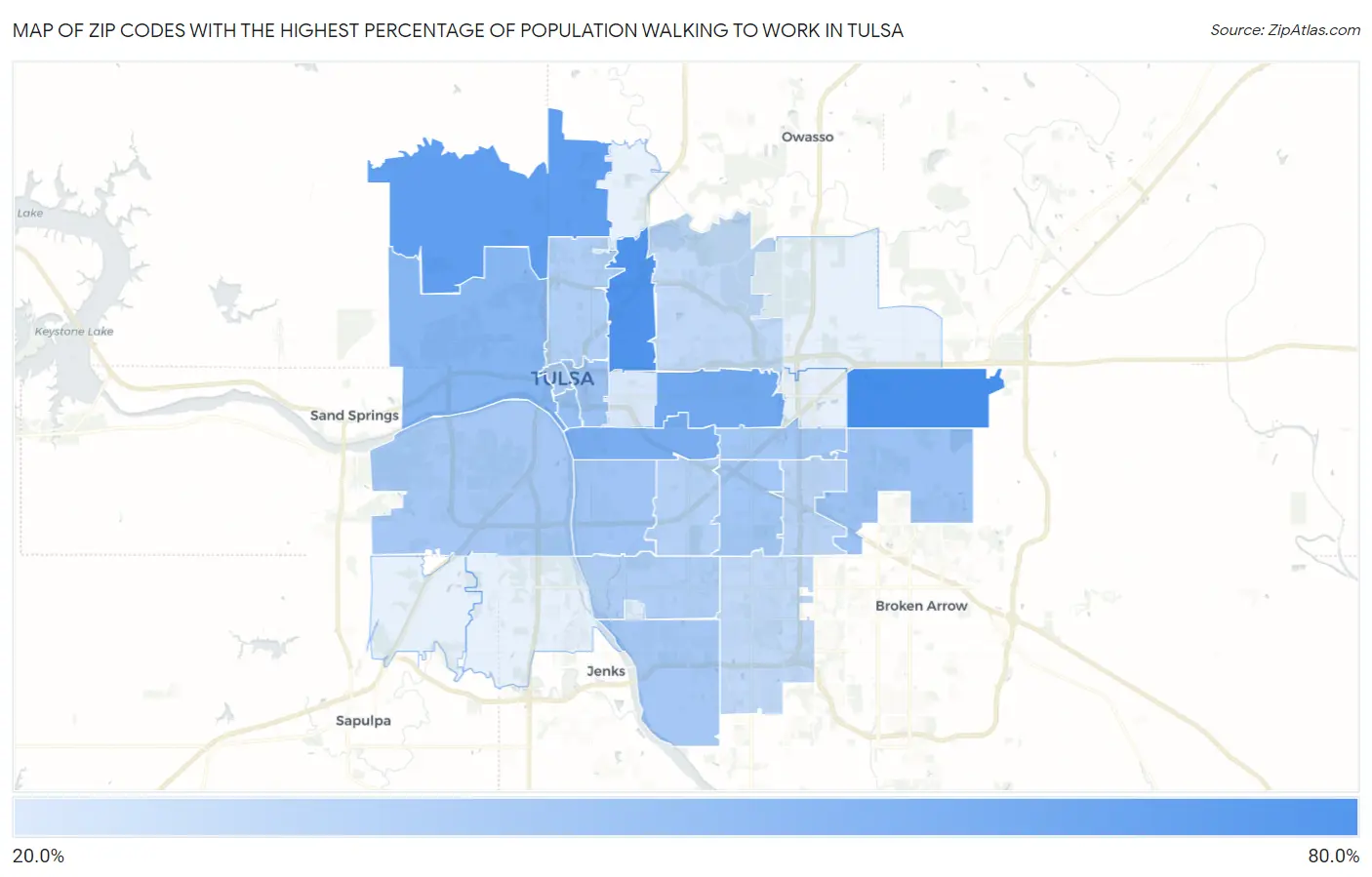Zip Codes with the Highest Percentage of Population Walking to Work in Tulsa, OK
RELATED REPORTS & OPTIONS
Walk to Work
Tulsa
Compare Zip Codes
Map of Zip Codes with the Highest Percentage of Population Walking to Work in Tulsa
0.0%
80.0%

Zip Codes with the Highest Percentage of Population Walking to Work in Tulsa, OK
| Zip Code | % Walk to Work | vs State | vs National | |
| 1. | 74108 | 60.1% | 33.5%(+26.6)#25 | 33.4%(+26.7)#1,433 |
| 2. | 74110 | 57.2% | 33.5%(+23.7)#36 | 33.4%(+23.8)#2,215 |
| 3. | 74126 | 52.8% | 33.5%(+19.3)#55 | 33.4%(+19.4)#3,575 |
| 4. | 74112 | 47.2% | 33.5%(+13.7)#83 | 33.4%(+13.8)#5,610 |
| 5. | 74114 | 45.6% | 33.5%(+12.1)#91 | 33.4%(+12.2)#6,181 |
| 6. | 74127 | 41.4% | 33.5%(+7.90)#116 | 33.4%(+8.00)#7,816 |
| 7. | 74119 | 37.9% | 33.5%(+4.40)#140 | 33.4%(+4.50)#9,276 |
| 8. | 74134 | 36.2% | 33.5%(+2.70)#156 | 33.4%(+2.80)#10,006 |
| 9. | 74120 | 36.1% | 33.5%(+2.60)#157 | 33.4%(+2.70)#10,049 |
| 10. | 74105 | 34.9% | 33.5%(+1.40)#168 | 33.4%(+1.50)#10,563 |
| 11. | 74145 | 34.5% | 33.5%(+1.000)#173 | 33.4%(+1.10)#10,762 |
| 12. | 74129 | 34.4% | 33.5%(+0.900)#178 | 33.4%(+1.00)#10,825 |
| 13. | 74107 | 34.1% | 33.5%(+0.600)#180 | 33.4%(+0.700)#10,926 |
| 14. | 74137 | 33.8% | 33.5%(+0.300)#182 | 33.4%(+0.400)#11,044 |
| 15. | 74103 | 32.7% | 33.5%(-0.800)#195 | 33.4%(-0.700)#11,513 |
| 16. | 74136 | 31.6% | 33.5%(-1.90)#204 | 33.4%(-1.80)#11,950 |
| 17. | 74106 | 30.8% | 33.5%(-2.70)#207 | 33.4%(-2.60)#12,285 |
| 18. | 74135 | 30.4% | 33.5%(-3.10)#215 | 33.4%(-3.00)#12,465 |
| 19. | 74146 | 29.4% | 33.5%(-4.10)#224 | 33.4%(-4.00)#12,855 |
| 20. | 74115 | 27.3% | 33.5%(-6.20)#238 | 33.4%(-6.10)#13,616 |
| 21. | 74133 | 27.2% | 33.5%(-6.30)#240 | 33.4%(-6.20)#13,634 |
| 22. | 74104 | 21.6% | 33.5%(-11.9)#284 | 33.4%(-11.8)#15,513 |
| 23. | 74171 | 20.6% | 33.5%(-12.9)#291 | 33.4%(-12.8)#16,054 |
1
Common Questions
What are the Top 10 Zip Codes with the Highest Percentage of Population Walking to Work in Tulsa, OK?
Top 10 Zip Codes with the Highest Percentage of Population Walking to Work in Tulsa, OK are:
What zip code has the Highest Percentage of Population Walking to Work in Tulsa, OK?
74108 has the Highest Percentage of Population Walking to Work in Tulsa, OK with 60.1%.
What is the Percentage of Population Walking to Work in Tulsa, OK?
Percentage of Population Walking to Work in Tulsa is 31.6%.
What is the Percentage of Population Walking to Work in Oklahoma?
Percentage of Population Walking to Work in Oklahoma is 33.5%.
What is the Percentage of Population Walking to Work in the United States?
Percentage of Population Walking to Work in the United States is 33.4%.